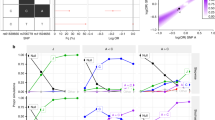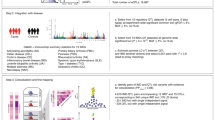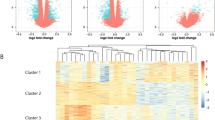Abstract
We used the Immunochip array to analyze 2,816 individuals with juvenile idiopathic arthritis (JIA), comprising the most common subtypes (oligoarticular and rheumatoid factor–negative polyarticular JIA), and 13,056 controls. We confirmed association of 3 known JIA risk loci (the human leukocyte antigen (HLA) region, PTPN22 and PTPN2) and identified 14 loci reaching genome-wide significance (P < 5 × 10−8) for the first time. Eleven additional new regions showed suggestive evidence of association with JIA (P < 1 × 10−6). Dense mapping of loci along with bioinformatics analysis refined the associations to one gene in each of eight regions, highlighting crucial pathways, including the interleukin (IL)-2 pathway, in JIA disease pathogenesis. The entire Immunochip content, the HLA region and the top 27 loci (P < 1 × 10−6) explain an estimated 18, 13 and 6% of the risk of JIA, respectively. In summary, this is the largest collection of JIA cases investigated so far and provides new insight into the genetic basis of this childhood autoimmune disease.
This is a preview of subscription content, access via your institution
Access options
Subscribe to this journal
Receive 12 print issues and online access
$209.00 per year
only $17.42 per issue
Buy this article
- Purchase on Springer Link
- Instant access to full article PDF
Prices may be subject to local taxes which are calculated during checkout


Similar content being viewed by others
References
Ravelli, A. & Martini, A. Juvenile idiopathic arthritis. Lancet 369, 767–778 (2007).
Prahalad, S. et al. Quantification of the familial contribution to juvenile idiopathic arthritis. Arthritis Rheum. 62, 2525–2529 (2010).
Prahalad, S., Shear, E.S., Thompson, S.D., Giannini, E.H. & Glass, D.N. Increased prevalence of familial autoimmunity in simplex and multiplex families with juvenile rheumatoid arthritis. Arthritis Rheum. 46, 1851–1856 (2002).
Petty, R.E. et al. International League of Associations for Rheumatology classification of juvenile idiopathic arthritis: second revision, Edmonton, 2001. J. Rheumatol. 31, 390–392 (2004).
Thompson, S.D. et al. The susceptibility loci juvenile idiopathic arthritis shares with other autoimmune diseases extend to PTPN2, COG6, and ANGPT1. Arthritis Rheum. 62, 3265–3276 (2010).
Thompson, S.D. et al. Genome-wide association analysis of juvenile idiopathic arthritis identifies a new susceptibility locus at chromosomal region 3q13. Arthritis Rheum. 64, 2781–2791 (2012).
Hinks, A. et al. Association between the PTPN22 gene and rheumatoid arthritis and juvenile idiopathic arthritis in a UK population: further support that PTPN22 is an autoimmunity gene. Arthritis Rheum. 52, 1694–1699 (2005).
Prahalad, S. et al. Variants in TNFAIP3, STAT4, and C12orf30 loci associated with multiple autoimmune diseases are also associated with juvenile idiopathic arthritis. Arthritis Rheum. 60, 2124–2130 (2009).
Hinks, A. et al. Association of the IL2RA/CD25 gene with juvenile idiopathic arthritis. Arthritis Rheum. 60, 251–257 (2009).
Hinks, A. et al. Overlap of disease susceptibility loci for rheumatoid arthritis and juvenile idiopathic arthritis. Ann. Rheum. Dis. 69, 1049–1053 (2010).
Hinks, A. et al. Association of the CCR5 gene with juvenile idiopathic arthritis. Genes Immun. 11, 584–589 (2010).
Hinks, A. et al. Association of the AFF3 gene and IL2/IL21 gene region with juvenile idiopathic arthritis. Genes Immun. 11, 194–198 (2010).
Albers, H.M. et al. Association of the autoimmunity locus 4q27 with juvenile idiopathic arthritis. Arthritis Rheum. 60, 901–904 (2009).
Prahalad, S. et al. Association of two functional polymorphisms in the CCR5 gene with juvenile rheumatoid arthritis. Genes Immun. 7, 468–475 (2006).
Cortes, A. & Brown, M.A. Promise and pitfalls of the Immunochip. Arthritis Res. Ther. 13, 101 (2011).
Hollenbach, J.A. et al. Juvenile idiopathic arthritis and HLA class I and class II interactions and age-at-onset effects. Arthritis Rheum. 62, 1781–1791 (2010).
Thomson, W. et al. Juvenile idiopathic arthritis classified by the ILAR criteria: HLA associations in UK patients. Rheumatology (Oxford) 41, 1183–1189 (2002).
Vang, T. et al. Autoimmune-associated lymphoid tyrosine phosphatase is a gain-of-function variant. Nat. Genet. 37, 1317–1319 (2005).
Remmers, E.F. et al. STAT4 and the risk of rheumatoid arthritis and systemic lupus erythematosus. N. Engl. J. Med. 357, 977–986 (2007).
Liu, J.Z. et al. Dense fine-mapping study identifies new susceptibility loci for primary biliary cirrhosis. Nat. Genet. 44, 1137–1141 (2012).
Juran, B.D. et al. Immunochip analyses identify a novel risk locus for primary biliary cirrhosis at 13q14, multiple independent associations at four established risk loci and epistasis between 1p31 and 7q32 risk variants. Hum. Mol. Genet. 21, 5209–5221 (2012).
Trynka, G. et al. Dense genotyping identifies and localizes multiple common and rare variant association signals in celiac disease. Nat. Genet. 43, 1193–1201 (2011).
Jin, Y. et al. Genome-wide association analyses identify 13 new susceptibility loci for generalized vitiligo. Nat. Genet. 44, 676–680 (2012).
Coenen, M.J. et al. Common and different genetic background for rheumatoid arthritis and coeliac disease. Hum. Mol. Genet. 18, 4195–4203 (2009).
Barrett, J.C. et al. Genome-wide association study and meta-analysis find that over 40 loci affect risk of type 1 diabetes. Nat. Genet. 41, 703–707 (2009).
Alcina, A. et al. The autoimmune disease–associated KIF5A, CD226 and SH2B3 gene variants confer susceptibility for multiple sclerosis. Genes Immun. 11, 439–445 (2010).
Eyre, S. et al. High-density genetic mapping identifies new susceptibility loci for rheumatoid arthritis. Nat. Genet. 44, 1336–1340 (2012).
Tsoi, L.C. et al. Identification of 15 new psoriasis susceptibility loci highlights the role of innate immunity. Nat. Genet. 44, 1341–1348 (2012).
Siepel, A. et al. Evolutionarily conserved elements in vertebrate, insect, worm, and yeast genomes. Genome Res. 15, 1034–1050 (2005).
King, D.C. et al. Evaluation of regulatory potential and conservation scores for detecting cis-regulatory modules in aligned mammalian genome sequences. Genome Res. 15, 1051–1060 (2005).
Andrés, A.M. et al. Balancing selection maintains a form of ERAP2 that undergoes nonsense-mediated decay and affects antigen presentation. PLoS Genet. 6, e1001157 (2010).
Cooper, J.D. et al. Seven newly identified loci for autoimmune thyroid disease. Hum. Mol. Genet. 21, 5202–5208 (2012).
Jostins, L. et al. Host-microbe interactions have shaped the genetic architecture of inflammatory bowel disease. Nature 491, 119–124 (2012).
Hinks, A. et al. Investigation of rheumatoid arthritis susceptibility loci in juvenile idiopathic arthritis confirms high degree of overlap. Ann. Rheum. Dis. 71, 1117–1121 (2012).
Stranger, B.E. et al. Patterns of cis regulatory variation in diverse human populations. PLoS Genet. 8, e1002639 (2012).
Dimas, A.S. et al. Common regulatory variation impacts gene expression in a cell type–dependent manner. Science 325, 1246–1250 (2009).
Grundberg, E. et al. Mapping cis- and trans-regulatory effects across multiple tissues in twins. Nat. Genet. 44, 1084–1089 (2012).
Ramensky, V., Bork, P. & Sunyaev, S. Human non-synonymous SNPs: server and survey. Nucleic Acids Res. 30, 3894–3900 (2002).
Rasmussen, A. et al. The lupus family registry and repository. Rheumatology (Oxford) 50, 47–59 (2011).
Karlson, E.W. et al. A connective tissue disease screening questionnaire for population studies. Ann. Epidemiol. 5, 297–302 (1995).
Gaffney, P.M. et al. Genome screening in human systemic lupus erythematosus: results from a second Minnesota Cohort and combined analyses of 187 sib-pair families. Am. J. Hum. Genet. 66, 547–556 (2000).
Packham, J.C. & Hall, M.A. Long-term follow-up of 246 adults with juvenile idiopathic arthritis: functional outcome. Rheumatology (Oxford) 41, 1428–1435 (2002).
Adib, N. et al. Association between duration of symptoms and severity of disease at first presentation to paediatric rheumatology: results from the Childhood Arthritis Prospective Study. Rheumatology (Oxford) 47, 991–995 (2008).
Moncrieffe, H. et al. Generation of novel pharmacogenomic candidates in response to methotrexate in juvenile idiopathic arthritis: correlation between gene expression and genotype. Pharmacogenet. Genomics 20, 665–676 (2010).
The Wellcome Trust Case Control Consortium. Genome-wide association study of 14,000 cases of seven common diseases and 3,000 shared controls. Nature 447, 661–678 (2007).
Beyersdorff, A. et al. Survey of Neonates in Pomerania (SniP): a population based analysis of the mothers' quality of life after delivery with special relations to their social integration. Int. J. Public Health 53, 87–95 (2008).
Patterson, N., Price, A.L. & Reich, D. Population structure and eigenanalysis. PLoS Genet. 2, e190 (2006).
Price, A.L. et al. Principal components analysis corrects for stratification in genome-wide association studies. Nat. Genet. 38, 904–909 (2006).
Hosmer, D.W. & Lemeshow, S. Applied Logistic Regression (Wiley, New York, 1989).
Purcell, S. et al. PLINK: a tool set for whole-genome association and population-based linkage analyses. Am. J. Hum. Genet. 81, 559–575 (2007).
Yang, J., Lee, S.H., Goddard, M.E. & Visscher, P.M. GCTA: a tool for genome-wide complex trait analysis. Am. J. Hum. Genet. 88, 76–82 (2011).
Yang, J. et al. Common SNPs explain a large proportion of the heritability for human height. Nat. Genet. 42, 565–569 (2010).
Pruim, R.J. et al. LocusZoom: regional visualization of genome-wide association scan results. Bioinformatics 26, 2336–2337 (2010).
Acknowledgements
We thank P. Gilbert for preparing UK JIA case samples for genotyping and M. Ryan for preparing US JIA case samples and the Cincinnati local control samples. Genotyping of the US JIA, German JIA and respective control collections was supported by US National Institutes of Health (NIH) grants RC1-AR-058587 and U01-AI-067150S1. In addition, subject recruitment and DNA preparation in the United States was largely funded by US NIH grants N01-AR-42272, P01-AR-048929 and P30-AR-473639, with contributions from the Arthritis Foundation, The Val A. Browning Charitable Foundation in Salt Lake City, Utah, and the Marcus Foundation, Inc., in Atlanta, Georgia, as well as US NIH grants K23-AR-50177 and R01-AR-060893. The Federal Ministry of Education and Research, Germany (BMBF grants 01GM0907 and 01 ZZ 0403) supported subject recruitment and sample preparation in Germany. Genotyping of the UK JIA case samples was supported by Arthritis Research UK (grant 17552). Sparks Childhood Arthritis Response to Medication Study was funded by Sparks, UK (08ICH09) and the Big Lottery Fund, UK (RG/1/010135231). The study is on the UK Medicines for Children Research Network (MCRN) portfolio. We acknowledge support from the Wake Forest School of Medicine Center for Public Health Genomics and the National Institute of Arthritis and Musculoskeletal and Skin Diseases (NIAMS; R01-AR-057106) for computing resources and data analysis.
Control sample recruitment and genotyping originating at the Oklahoma Medical Research Foundation (OMRF) was supported in part by NIH grants N01-AR-62277, P30-GM-103510, U19-AI-082714 and P30-AR-053483 from NIAMS, the National Institute of General Medicine Sciences (NIGMS) and the National Institute of Allergy and Infectious Diseases (NIAID). The contents are solely the responsibility of the authors and do not necessarily represent the official views of these institutes or the US NIH.
We thank J. Barrett and C. Wallace for the SNP selection. We thank the Wellcome Trust Sanger Institute Genotyping Facility and, in particular, E. Gray, S. Bumpstead, D. Simpkin and H. Blackburn for typing the UK samples. We acknowledge use of DNA from the UK Blood Services collection of common controls (UKBS-CC collection), which is funded by Wellcome Trust grant 076113/C/04/Z and by a National Institute for Health Research program grant to National Health Service Blood and Transplant (RP-PG-0310-1002). We acknowledge the use of DNA from the British 1958 Birth Cohort Collection, which is funded by UK Medical Research Council grant G0000934 and Wellcome Trust grant 068545/Z/01. Genotyping of control samples was supported, in part, by grants from Juvenile Diabetes Research Foundation International (JDRF) and the US NIH (U01 DK062418).
We thank P.K. Gregersen at the Feinstein Institute for providing US control genotyping from the Genotype and Phenotype Registry supported by US NIH grant RC2AR059092. We thank the National Institute of Diabetes, Digestive and Kidney Diseases Inflammatory Bowel Disease (NIDDK IBD) Genetics Consortium for providing North American control genotyping supported by US NIH grants DK062431, DK062422, DK062420, DK062432, DK062423, DK062413 and DK062429.
We gratefully acknowledge contributions from physicians at CCHMC and collaborating clinics. We also acknowledge the assistance of S. Kramer, B. Clifford and L. Ponder in subject recruitment and coordination of clinical information at Cincinnati Children's Hospital Medical Center, the University of Utah and Emory University, respectively. The Cincinnati normal control DNA collection was supported and made available by Cincinnati Children's Hospital Medical Center.
Author information
Authors and Affiliations
Consortia
Contributions
S.D.T., W.T., C.D.L., S.P., M.C.M., J.C. and A.H. led the study. A.H., J.C., M.C.M., C.D.L., S.P., W.T. and S.D.T. wrote the manuscript. A.H., J.C., C.D.L., M.C.M., M.S., S.P., J.B., M.E.C. and S.S. performed the data and statistical analyses. A.H. and P.M. performed the bioinformatics analysis. D.N.G., J.P.H., J.F.B., R.A., M.B., W.-M.C., P.C., P.D., S. Edkins, S. Eyre, P.M.G., S.L.G., J.M.G., S.E.H., J.A.J., M.K., K.L.M., P.A.N., S.O.-G., M.L.O., C.D.R., S.S.R., K.J.A.S., E.K.W., C.A.W., L.R.W. and P.W. contributed primarily to subject ascertainment, sample collection and/or genotyping. All authors reviewed the final manuscript.
Corresponding author
Ethics declarations
Competing interests
The authors declare no competing financial interests.
Additional information
A list of members and affiliations appears in the Supplementary Note.
A list of members and affiliations appears in the Supplementary Note.
A list of members and affiliations appears in the Supplementary Note.
A list of members and affiliations appears in the Supplementary Note.
A list of members and affiliations appears in the Supplementary Note.
A list of members and affiliations appears in the Supplementary Note.
A list of members and affiliations appears in the Supplementary Note.
A list of members and affiliations appears in the Supplementary Note.
A list of members and affiliations appears in the Supplementary Note.
Supplementary information
Supplementary Text and Figures
Supplementary Note, Supplementary Tables 1–8 and Supplementary Figures 1–4 (PDF 3217 kb)
Rights and permissions
About this article
Cite this article
Hinks, A., Cobb, J., Marion, M. et al. Dense genotyping of immune-related disease regions identifies 14 new susceptibility loci for juvenile idiopathic arthritis. Nat Genet 45, 664–669 (2013). https://doi.org/10.1038/ng.2614
Received:
Accepted:
Published:
Issue Date:
DOI: https://doi.org/10.1038/ng.2614
This article is cited by
-
Profiling the peripheral immune response to ex vivo TNF stimulation in untreated juvenile idiopathic arthritis using single cell RNA sequencing
Pediatric Rheumatology (2023)
-
Monogenic disorders as mimics of juvenile idiopathic arthritis
Pediatric Rheumatology (2022)
-
Whole exome sequencing in a juvenile idiopathic arthritis large family with SERPINA1 gene mutations
BMC Rheumatology (2022)
-
Genetic associations at regulatory phenotypes improve fine-mapping of causal variants for 12 immune-mediated diseases
Nature Genetics (2022)
-
Juvenile idiopathic arthritis
Nature Reviews Disease Primers (2022)



